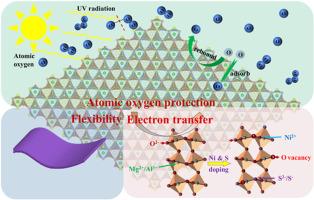Codoped stacked nanosheets for simultaneous atomic oxygen and electrostatic discharge protection in space environments
IF 8.2
2区 材料科学
Q1 MATERIALS SCIENCE, MULTIDISCIPLINARY
引用次数: 0
Abstract
Layered double hydroxides (LDHs) have garnered considerable attention owing to their unique layered structure. Recently, the excellent barrier effect of stacking LDH nanosheets has been found and demonstrated great potential for atomic oxygen (AO) protection in low Earth orbit (LEO) where space stations and Starlink satellites operate. However, the inherent wide bandgap and the resulting highly insulating nature of LDHs make them vulnerable to electrostatic discharge (ESD), posing a critical challenge for space applications. Here, we proposed to codope (Mg,Al)-LDHs with sulfur and nickel to prepare conductive LDHs and satisfy the requirement for both ESD and AO protection. By coating the doped-LDHs on polyimide film, we achieve layered structure formed by interlaced LDH nanoflakes. The sheet resistance is reduced by four orders of magnitude compared with unmodified LDHs. More importantly, the coated polyimide film exhibits simultaneous protections against ESD (sheet resistance of 5.77 × 108 Ω/sq well below the necessary of 1010 Ω/sq) and atomic oxygen (weight gain was about 7.40 mg/cm2 under 4.35 × 1020 atoms/cm2 of AO influence and 50 ESH of UV radiation). Unlike conventional strategies that mitigate AO erosion by increasing material density, this approach leverages the adsorption properties of LDHs. Doping enhances the capacity of LDHs to adsorb AO, offering a novel strategy for space environment protection.

空间环境中原子氧和静电放电同时防护的共掺杂堆叠纳米片
层状双氢氧化物(LDHs)由于其独特的层状结构而引起了广泛的关注。最近,堆积LDH纳米片的优异屏障效应被发现,并显示出在空间站和Starlink卫星运行的低地球轨道(LEO)中保护原子氧(AO)的巨大潜力。然而,ldh固有的宽带隙和由此产生的高度绝缘特性使其容易受到静电放电(ESD)的影响,这对空间应用构成了严峻的挑战。本文提出将(Mg,Al)-LDHs与硫、镍共涂制备导电LDHs,同时满足ESD和AO保护的要求。通过在聚酰亚胺薄膜上涂覆掺杂的LDH,我们实现了交错LDH纳米片的层状结构。与未改性的ldh相比,薄片电阻降低了4个数量级。更重要的是,涂覆的聚酰亚胺薄膜同时具有防静电(片电阻5.77 × 108 Ω/sq,远低于所需的1010 Ω/sq)和原子氧(在4.35 × 1020原子/cm2的AO影响下,重量增加约7.40 mg/cm2,紫外线辐射50 ESH)的保护作用。与通过增加材料密度来减轻AO侵蚀的传统策略不同,该方法利用了LDHs的吸附特性。掺杂提高了LDHs对AO的吸附能力,为空间环境保护提供了新的策略。
本文章由计算机程序翻译,如有差异,请以英文原文为准。
求助全文
约1分钟内获得全文
求助全文
来源期刊

Materials Today Nano
Multiple-
CiteScore
11.30
自引率
3.90%
发文量
130
审稿时长
31 days
期刊介绍:
Materials Today Nano is a multidisciplinary journal dedicated to nanoscience and nanotechnology. The journal aims to showcase the latest advances in nanoscience and provide a platform for discussing new concepts and applications. With rigorous peer review, rapid decisions, and high visibility, Materials Today Nano offers authors the opportunity to publish comprehensive articles, short communications, and reviews on a wide range of topics in nanoscience. The editors welcome comprehensive articles, short communications and reviews on topics including but not limited to:
Nanoscale synthesis and assembly
Nanoscale characterization
Nanoscale fabrication
Nanoelectronics and molecular electronics
Nanomedicine
Nanomechanics
Nanosensors
Nanophotonics
Nanocomposites
 求助内容:
求助内容: 应助结果提醒方式:
应助结果提醒方式:


